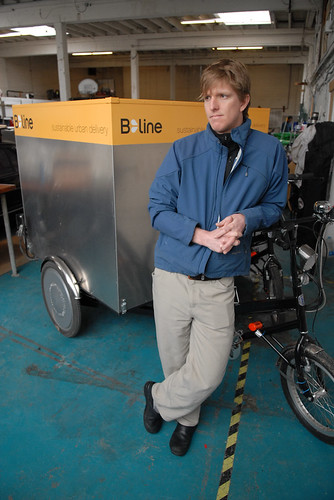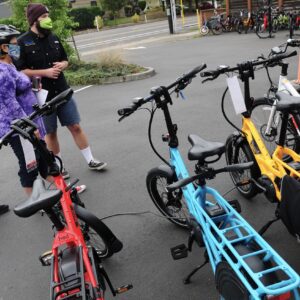Last week the Oregon Department of Transportation announced the availability of $4 million in incentives for electric trucks. The money comes from the federal government’s Congestion Mitigation and Air Quality (CMAQ) program and it’s aimed at, “encouraging the purchase of zero-emission urban delivery trucks.”
Unfortunately the money (which comes in the form of $20,000 vouchers per qualifying vehicle) cannot be used to purchase cargo trikes and other vehicles that use human-power in addition to electric assist. One stipulation of the grants is that the vehicles weight over 10,000 pounds.
The goal of this program is to reduce greenhouse gas emissions, so it seems promoting more freight to be delivered with pedal-powered trucks would make a lot of sense. It’s too bad that ODOT doesn’t yet embrace the type of freight vehicles used with much success by Portland companies like B-Line and Portland Pedal Power.
“By limiting the EV incentives to vehicles of 10,000 lbs or more, the current push for EV delivery fleets is short-sighted.”
— Franklin Jones, CEO of B-Line Sustainable Urban Delivery
I brought up this issue when I sat down with ODOT Director Matt Garrett back in April. He said that was the first he’d ever heard of using pedal-powered vehicles to deliver freight in urban areas and that folding such vehicles into ODOT’s suite of EV incentive programs had simply never been discussed.
I asked Franklin Jones, CEO and Founder of B-Line, for his reaction to ODOT’s new voucher program. He thinks ODOT is missing the boat (or should I say bike?).
Jones said he welcomes the new incentives because they will help reduce GHG emissions. But, he adds, “By limiting the EV incentives to vehicles of 10,000 lbs or more, the current push for EV delivery fleets is short-sighted.” Jones’ trikes weight about 500 pounds.
The way Jones sees it, ODOT’s push to promote a healthier planet misses key components. “A downtown traffic jam of EVs is still a traffic jam,” he says, “and a driver of an EV isn’t gaining the health and wellness associated with cycling.”
By switching to more electric trucks, there may be a reduction in emissions, but, Jones wonders, “Will the vehicular landscape of our city really be all that different? Will we relate to each other differently just because we drive EV’s?”
Jones is getting at some of the key attributes in investing in more pedal power that are often overlooked: more space for other things (more vehicles, more parks, more buildings), more public health benefits, and the greater sense of community that arises when people lose the steel shell of cars and trucks and see fellow citizens face to face and experience cities with more than just their eyes.
But this isn’t just a feel-good argument from Jones. He points to several others cities where pedal-powered freight delivery is taking off (MetroPed in Boston, Revolution Rickshaw in New York City, SHIFT Urban Delivery in Vancouver, BC, and so on). “There is a false assumption that there is no alternative for supplying goods and services into our urban core.”
In London, Office Depot has expanded their bike delivery fleet in anticipation of clogged streets during the Olympics.
And then there are the safety benefits of getting “killer trucks” of city streets, as highlighted in this article posted today on TreeHugger.com.
In the end, Franklin says he’s like to see ODOT adopt a broader definition of EVs and he’d like to see EV charging stations include ports appropriate for e-bikes.
“Both of these measures,” says Jones, “would go a long way to promoting a truly sustainable and prosperous city.”







Thanks for reading.
BikePortland has served this community with independent community journalism since 2005. We rely on subscriptions from readers like you to survive. Your financial support is vital in keeping this valuable resource alive and well.
Please subscribe today to strengthen and expand our work.
“I brought up this issue when I sat down with ODOT Director Matt Garrett back in April. He said that was the first he’d ever heard of using pedal-powered vehicles to deliver freight in urban areas and that folding such vehicles into ODOT’s suite of EV incentive programs had simply never been discussed.”
Has this guy never been to Portland? Great to hear that the policymakers are making far-reaching decisions that affect our quality of life, yet they are really disconnected from what actually is going on at ground level in the city.
Man! Would someone [BTA, etc.] mail him this book:
Carfree Cities by J.H. Crawford
It has a great section discussing inner city freight and goods movement that is human scaled. Even though the book is now 12 years old ! – it is still one of the best complete reads on this topic.
“Carfree Cities offers a practical solution to the many urban problems caused by cars and trucks. The carfree city saves energy, preserves the environment, and improves the quality of our lives.”
Quick! Somebody design a 10,000 pound e-cargo bike!
Does a 10,000 pound E-vehicle have enough power to even get out of its own way? What is the latest technology offering?
I was wondering about the viability of this as well… batteries big enough to move a large loaded truck probably weigh as much as a car…
it’s too bad they excluded light city delivery vehicles… every little bit helps…
http://smithelectric.com/
Interesting, thanks. And the large, flat roofs just beg for PV panels…
That’s a great idea. Definitely would help extend the range.
Quick calculation: an e-bike equipped with 63 full kegs would meet the 10,000 lb requirement. You could probably get away with a mere five dozen kegs once you figure the weight of the frame and such. I don’t know, though, whether fuel counts toward gross weight or not. If it does, that $20,000 will buy you five dozen Hopworks kegs with deposit and a chunk left over for construction costs. Have I had too much fuel to wonder whether Kickstarter might cover the rest?
I’m assuming the 10,000lb requirement is for empty vehicle weight.
For example, this truck has a version that is just over 10,000lbs and has roughly a 16,000lb cargo capacity:
http://www.ecofriend.com/entry/electric-trucks-with-no-environment-hiccups-coming-to-us/
I think they need a 2nd tier category that could cover e-truck bikes. 500lb empty weight would get a $1,000 incentive.
I think that we need to work via our state reps/senators to get a cultural change in ODOT. The fact that it was never discussed – augh.
“the greater sense of community that arises when people lose the steel shell of cars and trucks and see fellow citizens face to face and experience cities with more than just their eyes” YES!
What we need is something like a electric cargo bike / pallet jack hybrid.
There will be in the near future a big demand for micro shipments in dense urban areas. Local cargo delivery logistics, the “last mile” problem, plague in scenarios like the CarFree City or Cargocap are glossed of as “and once freight gets close it isn’t a problem.
We will see scenarios where weighty freight (500-2000lbs) needs to be moved short distances (0.1-0.75mi).
From a pure practicality and cost benefits standpoint we will soon see a larger standardization of palletized freight such that individual pallets will move with the flexibility and ease of larger containerized freight boxes we see on ships, trains and trucks.
The cargo bike industry needs to be positioning itself to be the prime choice for delivering that pallet the final distance.
One pallet per bike is probably the optimal initial design target through a double bike trailer setup should be considered for moving more bulky light cargo.
If we can make a cargo bike that efficiently delivers the customer’s pallet of goods to their door exactly where need it rather than inside of truck trailer requiring an extra worker for truck unloading it might just be what business wants.
You’re basically describing our business model at B-line. We send out between 3 & 12 pallets of various products a day, covering the last leg (.1 to 2.5 miles) of the supply chain. With a payload of 600-800 lbs. we’re working hard to make pedal powered e-assisted cargo bikes a viable option for B2B delivery in the urban core.
Are you moving actual pallets or a roughly equivalent volume of cargo?
Ultimately what has done the most to make freight movement more efficient was the move from “break bulk” cargo to standardized shipping containers. This has made the need for longshoremen nonexistent unless you are casting for a movie with a historic setting.
If you are touching the freight in any way other than securing and transporting it your business model is reminiscent of the longshoremen problem and ultimately will be costed out of existence.
Don’t get me wrong: what you’re doing is great. To truly make a difference cargo bike freight delivery needs to “knock it up a notch” or it will remain a local niche industry. It needs to be cutthroat price competitive. In the current environment that would mean off loading individual pallets as close as is safe to bring a large truck to downtown, tarping pallets as needed and delivering them as efficiently as possible to their destination downtown.
You’ll need to be bicycle powered pallet jack.
I agree that ODOT is really missing the boat on this one. As someone who is frequently a pedestrain downtown (I work downtown) I find it difficult and often dangerous to contend with large trucks. It doesn’t matter if they are an EV or not. They are big, their visibility is limited, and they aren’t exactly nimble vehicles either.
Now granted, looking at the big picture I am a supporter of EV technology in cars and trucks. However, nothing will change the fact that cargo bikes (particularly e-bikes for heavy loads) have a huge number of advantages, especially in the dense downtown environment. I see the folks from B-Line all the time and I’ve never had to jump out of their way. Nor has the noise from a B-Line bike ever nearly popped my ear drums. I’ve never had my path blocked by a B-Line bike either.
In other words, it just simply makes sense!
Dang it… Now I’m all riled up. Looks like I’m going to be writing a letter to ODOT when I get off work today.
I think ODOT should give B-Line $20,000 per bicycle.
Then I will start my own “freight” company, buy 10 bikes and make a single delivery in each. Heck, I could make the deliveries for free. Then take the rest of the year off and go to Hawaii.
Seems like a simple oversight on ODOTs part, per their own admission. Perhaps this article will be enough for them to raise the topic during the next budget cycle?
Thanks, Jonathan, for bringing this up. I’ll also note for folks that the Statewide Transportation Strategy includes a lengthy discussion about freight but never mentions bike freight. The strategy’s open for public comment until July 20th. http://www.oregon.gov/ODOT/TD/OSTI/pages/sts.aspx
JM:
I shot off an inquiry to Bill Stites about his Truck Trike and its applicability to this this situation.
From his reply and comments by and about B-Line’s use of this “heavy cargo trike” it seems that a followup story involving B-Line and Stites about the progression and functionality of this vehicle would be timely.
Also he sent this link to a Youtube video about how the preloaded cargo box/pallet idea on electric cargo trikes is working out for FedEx in France. There are english subtitles.
Thanks q’Tzal, I’m a huge admirer of Bill’s and you’re right.. I’m overdue to talk with him and I should have included him in this story. I wish a local company was using his trikes! Cheers.
Thanks for bringing this to light Jonathan.
It’s too bad the new vehicle class of “human-electric powered trikes in the 300 lb. [GVW] range” has not permeated ODOT consciousness yet. As various pressures come to bear – most notably safety and congestion keeping bigger trucks out of inner cities – I suspect ODOT will come around as it is simply very logical.
We are working on refining the concept, and have learned a lot from B-Line’s feedback on our prototype. We’ve just finished the second generation, but need to do an update on our website … new photos soon.
The idea of standardized pallets or containers makes a lot of sense. The logistics will be challenging, but certainly doable. The link q’Tzal shared above is HAPPENING TODAY in Paris. We are behind the times, folks.
Also, I attended a recent electric vehicle conference [EV RoadMap 5], and freight was a big topic this time around. Of note, one of the Smith trucks has a GVW of 22K lbs and a payload capacity of 9K lbs. Thus, even at full payload, the vehicle uses energy to move 31K lbs. when the true goal is to move 9K lbs.! Sure, they have their place in the delivery chain, but that is intrinsically inefficient. Even though it’s clean energy … it’s A LOT of energy.
The beauty and elegance of cargo bikes and trikes is that they CARRY MORE THAN THEY WEIGH. For the fated “last mile”, the size of the vehicle ought to more appropriately match the size of the payload. Note that the 300 lb. trike noted above carries a payload of 600 lbs. plus driver.
Being on the correct side of the vehicle/cargo weight ratio is the key to high efficiency IMO.